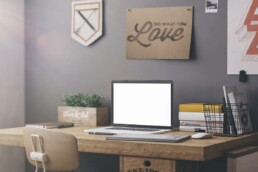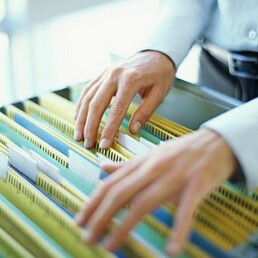What Happens When We Become Organized?
The things we keep in our workspace/office exposes what we decided will enhance our career, job, expertise, life, or business. When papers pile up or are dumped unsorted in boxes, this is an indication these items no longer serve you.
Getting organized will help you take back control. Until then, colleagues or spouses may think your workspace’s mess reflects your state of mind. “I know where everything is,” you’ll retort. “I can always find what I need.”
The problem is you won’t always be around to find a project or file due to a hospital stay, vacation, sick day, or out-of-town conference.
If you lose important papers or electronic files, you cannot pass on important knowledge, keep the information for company records or history, or find what you or others need.
When information gets missed, productivity and the company can suffer.
You know getting organized helps you, but did you know it will boost your work financially, emotionally, physically, and spiritually? See how below:
Financial Benefits
- Only keeping what you really need compels you to focus on projects and goals you value most — allowing you to better meet company goals and faster
- A cleared space leads to increased productivity, and a more profitable employee
- By organizing supplies, avoid repurchasing those you have (save money!) and allows you to plan what you need in the next supply order
- Instead of wasting time looking for files, you can spend your time effectively by being a more productive employee
Emotional Benefits
- Feels like huge weight lifted off you (“I must get to this” is now done)
- Seeing what’s really important to you may inspire you to pursue new projects, or a new role
- Lift away that guilty awareness that your space is cluttered
- With a cleared space, you clear your mind
- Each morning, instead of starting your day with frustration at the clutter and disorganization, you are ready to work on your newly identified goals
- Clearly see what is truly important to you at this stage of your career or business
- Become more passionately involved or feel recommitted to work
- Gain renewed confidence in decision-making abilities
- By confronting what we no longer need, we get to reset our work lives
- Make decisions based on newly identified values
Physical Benefits
- Spend less time searching for files or projects
- Reduce stress and feel less overwhelmed
- Find things you’ve been looking for
- Have room and feel comfortable to host meetings in your office
- Tackle projects hanging over your head untouched, ignored, or hidden
- Face your tendency to procrastinate
- By reducing files, have more room to work
- Digitize old files and that tower of business cards you won’t use
- Easy-to-maintain system, reflecting the individual personal work style, helps spaces stay clear, and productivity remain high
- Stand or sit at your desk properly, with an ergonomic computer set up, helping to reduce neck or lower back pain
- By selecting what you keep, make choices and decisions on your future
- With boxes gone, you have a clear path to your desk
- Organized files are at hand when you need them
Spiritual Benefits
- Organizing your work space can be reputation-enhancing, as colleagues and clients see you in control of your workflow
- Learning to let material go and giving away, recycling, and archiving files or items can be cathartic, leaving you with a feeling of freedom
- Items in your office are signs of what you value, and a reflection of what you want to get out of your career
- By digging out from stuff that has been burying you, you can forge ahead uncluttered, ready for change
- Feel ready to tackle projects you couldn’t bear to look at before
- Be more passionately involved and able to focus on what matters most
New Year, New Office Habits
You go to work every day, and there’s money for bills and food. It's a good time of year to ask: are you happy, or just satisfied?
I believe people make New Year’s resolutions because we always want to improve our performance as humans. Lose weight, save money, eat healthier…
How does that translate into our work lives? Could we be more satisfied? January seems like a good time to consider this.
According to Rana Florida, in her book, Upgrade, we can always decide to transform your career. “The reality is that the majority of us don’t think about how we can optimize our lives.” She says we just “slog through” in a state of “managed dissatisfaction.”
Good point. And it got me thinking.
Do most employees just go to work because it’s what you do every day? Do most Canadians feel engaged? Turns out, we do!
In 2018, Monster Canada found nearly two-thirds of Canadian employees are content with their jobs. That’s right. Canada has some of the most satisfied and engaged workers in the world!
What’s strange is that a few years before, a 2015 survey showed 82% of working Canadians feel extremely disorganized. So why the disparity between the two statistics?
I think some of the reason is the disorganized state of Canadian workspaces. With files (electronic and physical) disorganized, boxes stacked up, papers piled around, and business cards in disarray, etc., people’s minds feel cluttered. How can you start your day without that kind of guilt?
Employees, executives and entrepreneurs want to get rid of old projects and recycle unused or broken supplies and electronics, as well as paper and digital clutter, but don’t have time. Or the energy. Or know how.
It’s 2020. It’s a wonderful time to form new habits, and get that office, desk, or workspace organized. Let’s start your workday being inspired.
Paper Piles & Digital Disorganization Can Cost You
Some people embrace clutter. They love their messy office. They know exactly what’s in each and every one of their 27 piles of paper littering the desk, floor, windowsill, and credenza. ‘Go ahead and test me. I know what’s there,’ they say confidently.
Their computer desktop is littered with dozens of unsorted files. Their inbox holds emails in the tens of thousands. Maybe more than 100,000.
But what if that person has the flu, or is working in another time zone for a week. If they weren’t able to get to a computer or phone for a few days, would a colleague be able to find what they need in that messy office?
What if you were out longer, such as a serious illness or injury for a few months. Would it be intuitive for your colleagues to know where to access files, either in your office or on your electronic directory? Could they find everything to take over the project?
Here’s the thing: you may know where everything is, but no one else will understand your system. All they see is a high pile of paper leaning dangerously to the left. Or blocking the heating vent.
If they are allowed access to your digital files, your piles likely won't make sense to them. If files are buried in a system only you can understand, that spells trouble for the company.
When you hear someone say they know where everything is, ask if they have room on the desk to read, make notes, or edit a document. Is there space for water, a coffee cup, to review a file? Are several projects in one tall leaning-tower-of-Pisa style stack? That is probably not serving them well and could be a safety hazard.
And it costs.
Not being able to have clients in your office, or looking unprofessional if you do, affects your professional reputation. It looks like you aren’t in control. People wonder if the way you approach work is the same -- unkept and ignored.
Above all, it costs the company or your business by not sharing information with colleagues or clients on a regular basis.
it’s impossible for anyone else to know your system. If you have one. And if you don’t, I encourage employees and small business owners to file, have a spot for current projects, and archive those long over and complete, rather than let them sit in your office gathering dust. You’ll all benefit.
5 Tips for Smart Filing
For a supposed digital society, paper clutter is still an epidemic. And for others, the disorganization has just shifted from physical to digital.
If you don’t know how to handle scattered digital files at work, or the mountain of unsorted paper or in your office or home, let’s talk about how to manage papers and files.
1. Cut down how much you have. It’s difficult for some people to expel items, especially if they have an emotional attachment (promotion confirmation, first condo purchase). Honour the feeling, know the memory is stored, and then try to let it go. Only keep what you may need for legal reasons or to refer to in future.
Next, edit out these typical items in your home office or business workspace:
- Conference notes you’ve never looked at
- That “someday pile” of documents you’ve been meaning to sort
- Saving or collecting items you may need “sometime,” but never do
- Annual daily planners for years passed
- Completed projects unnecessary to keep
- Articles or bookmarked sites you are never going to read
Do you really need to print out an email or document? If you prefer to read a physical copy rather than a computer screen, research actually supports that preference (see study by Virginia Clinton, University of North Dakota). It’s more efficient to read from paper. However, ensure you recycle, file, or shred once you are finished editing or reading the document.
Keep vital documents such as your Social Security number, birth certificate, insurance policy, Estate & Will, property deed, car title, passport, and any contract or legal agreement with an original signature in a fireproof metal cabinet, safe, or safety deposit box.
To determine what’s vital, decide if replacing it would expensive, time-consuming, or vulnerable to fire, flood, or identity theft.
2. Be realistic about whether you will actually file what’s left, and if so, decide what kind of system you’ll likely use. If it’s too complicated or stressful, go digital. If you decide to keep hard copies of files, let’s go through options so you can store, track, and retrieve what you need.
- Alphabetical files (A-Z) / numerical (2019) / alphanumeric (CharityBall2019)
- Chronological
- By Broad Area Topic
- Family Tickler File
- Paper Tiger
- Smead Viewables
- Pendaflex Pilesmart
- Freedom Filer
3. Once you’ve chosen a system, think about what size file (letter or legal), if you want plain or colour-coded folders, and whether they will hang or sit in sorters. Keep these tips in mind:
- Put files into folders and label with date
- Don’t delay, but label new files as soon as you open them
- Be clear where outdated files go (why keeping it, storage, scan)
- Share files with others (central company drive)
- Ensure you set up files for business expenses, and to prepare for tax season
4. Go Digital. Set up an electronic filing that follows the company’s system, and if there’s none set up, establish your own. See if a “file naming convention” works for you.
- Add dates (back to front for chronological retrieval): 20150201Agenda (YYYYMMDD = Feb. 1, 2015)
- For Alphanumeric, use “0” so lists go in order automatically (MemberReport2014V02.doc)
- Add versions to drafts so lists are in order, but add final to last version (MemberReport2014Final.doc)
5. Maintain the system you put into place.
- Book time weekly to delete emails
- Set time to read articles
- Every Friday (or end of your work week) tidy at 4:30 pm
- Schedule seasonal file clear out and tidy days
Nobody has time or energy to expend looking for files. If you set aside time to stay organized, your workspace will be a more inviting place to work and create.
Heard About Swedish Death Cleaning?
While people around the world embrace Marie Kondo’s method of what sparks joy to declutter, those into their 50s and beyond are practicing the Swedish Death Cleaning method (SDC) or döstädning. In Swedish, dö is "death" and städning is "cleaning."
Sounds downright scary doesn’t it? I mean it has the word “death” in it.
The SDC philosophy is all about editing out unnecessary objects and clutter in your home over time to be left with only what's useful or a good memory. You slowly edit out items before your children or loved ones have to do it for you after you’ve died.
It’s the ultimate plan to be organized, but after death.
Although SDC advocates say clean it up now, it is really a philosophy of living.
It can start anytime, ideally in your 50s, beginning with small steps that involves organizing and purging out stuff daily, getting down to a minimum, and leaving behind a decluttered home.
While people have been scrutinizing their relationship with stuff lately, this method has been around for about two years, practiced by an aging generation.
From their 20s to 60s, the Baby Boomer Generation made good salaries, bought inexpensive homes, cars, and spent their wealth during the extravagant 1980s. All this stuff now packs their homes.
And many of those born in the 1940s, brought up in wartime, know what it is to lack. Therefore, many keep things that may come in handy. This can get out of control.
I’m generalizing here, but through either experience described above, many Baby Boomers have become collectors. They have stuff. And they expect their offspring will want it when they are gone.
Not so fast.
Their children are Generation Xers, and they have enough stuff. Excellent consumers, they can buy lots with cheap manufacturing, and as a result, have tons of clothes, furniture, and electronics. And now with online shopping, it's even easier to make our consumerism easier, faster, and more efficient.
They are collectors too. But also discarders.
Gen Xers get rid of their stuff in search of getting a better, updated, newer version.
Bottom line is most likely, Gen Xers won't want all your stuff.
Not that everything has to go. The SDC minimalist lifestyle still means you keep items that may have sentimental value to you or relatives. The point is that whatever’s left is not a burden on the family someday. Or you.
That gives SDC followers time to travel, watch movies, go to the theatre, or create elaborate meals. This is how priorities shift, when you spend less time shopping, collecting, and taking care of what you own.
When you think about it, Swedish Death Cleaning gives you more time to enjoy life. I like that.
Making Your Office Yours
As a new employee, you probably walked into your office or cubicle, and got right to work. After logging into your computer, you may have checked out the office supply situation.
You most likely didn’t go much beyond these steps. Most employees don’t adjust their chair or computer monitor to the right height, consider the best furniture configuration, sanitize the keyboard or mouse, or ponder whether they need everything in the space.
Given you sit in your workspace for years—potentially decades—these are important missed opportunities.
Most people don’t think of changing their office set up when walking into a new job. And some people don’t have that option (cubicle or built-in furniture). Yet, workspaces are not calibrated for YOUR highest efficiency—yet your needs will be different than the last employee.
So if you have some leeway, what should you do to make the office yours?
Consider where your desk faces. Most people don’t like colleagues or clients approaching from the back. Others don’t mind. Some people want to hide their computer monitor for privacy, while others need it visible to visitors. Only you can decide the best desk placement, so think about what you need. For example, if you have a window, it’d be refreshing to face it, but only if there aren’t people constantly standing or walking by outside, which could be distracting. Experiment with different options, and ensure you have an ergonomic set up.
Get rid of your filing cabinet. As we move further toward digital files only, we don’t need to physically file as much. If you are a low paper generator, and can make do with digital files only, make space for something else. For example, a small meeting table and chairs. You might even spring for a mini fridge to keep pop, water, or your lunch.
Put up those photos, degrees, and awards. So many employees have the best intentions of putting up framed posters, autographed pictures, and your children’s paintings, along with business-related frames. But that task often goes down the to-do list. Time to pick them off the floor, and make arrangements with the office manager to have them hung.
Add some personal touches. If it’s part of your job to review reports or publications, consider a reading chair, floor lamp, and side table. If you are an avid coffee or tea drinker, bring supplies and place on a tray so you can make it right there. Saves time, and money. And you may make new office friends!
Whether you are an employee, executive, or small business owner, it’s a great time to refresh your work life and set up your office how YOU want it. Make it yours.





